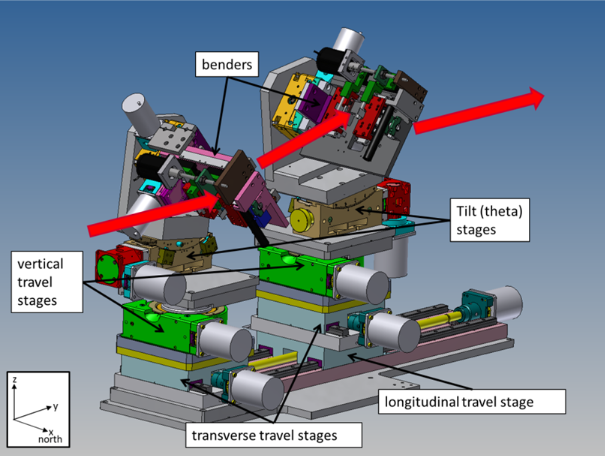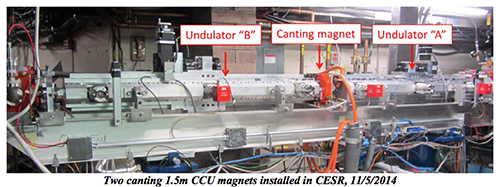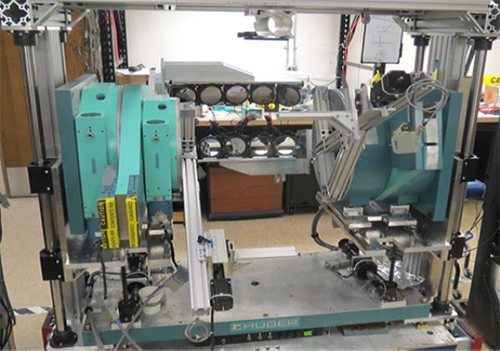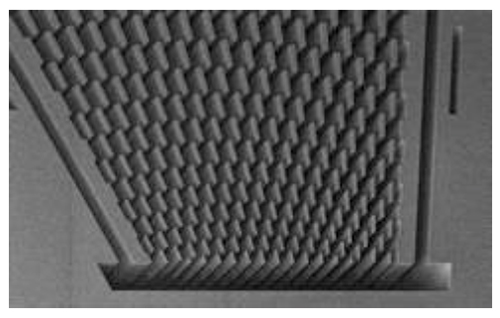X-RAY RUNS: Apply for Beamtime
2017 Nov 1 - Dec 21
2018 Feb 7 - Apr 3
2018 Proposal/BTR deadline: 12/1/17
2018 Apr 11 - Jun 4
2018 Proposal/BTR deadline: 2/1/18
Among the very few spectacles typically missing from New York’s famous Times Square is a collection of several hundred of the world’s experts in synchrotron radiation. That void was briefly filled from July 6-10, when the Marriott Marquis at 1535 Broadway hosted the 12th International Conference on Synchrotron Radiation Instrumentation (SRI). The international version of SRI is held every three years, and offers a rare opportunity for the global synchrotron community to share ideas and information specifically related to synchrotron science and technology. This year’s conference featured just under 200 talks scheduled in 4 parallel sessions, as well as over 400 poster presentations.
CHESS was well represented in the form of eight posters and seven talks, including the leading keynote address on Tuesday morning by CHESS Associate Director Matthew Miller. Professor Miller’s presentation was entitled “Understanding the Crystal Scale Performance of Structural Materials”, and described the context and many results from “In Situ @ CHESS”, a new center for developing and applying high energy diffraction and modeling to the study of structural materials. The center, which is based on the newly upgraded F2 station at CHESS, is supported by the US office of Naval Research and aims to combine simulation and measurement at length scales relevant to mechanical properties, such as inhomogeneous collections of gains in a polycrystalline metal. In a closely related talk from the instrumentation point of view, Peter Ko described the design and performance of the new F2 monochromator, a double-Laue design employing thin silicon wafers as described originally in work at Brookhaven National Laboratory in 2001. The CHESS mono features a CHESS-designed bender, and delivers approximately 1012 photons/second in a 1x1 mm2 spot at 40 keV. Finally, a poster presentation by Margaret Koker described the work-horse analytical technique of the center: the development at CHESS of high-energy grain-mapping by simultaneous collection of near- and far-field diffraction patterns.

The Double-Laue Monochromator assembly (Ko)
This year’s conference provided a particularly well-timed opportunity for CHESS to show off its knack for developing new, creative approaches to long-standing problems in instrumentation. As an example, Alexander (Sasha) Temnykh described the “special sauce” behind CHESS’s recent undulator upgrade: namely, the CHESS Compact Undulators (CCUs). As of October 2014, two CCUs, built by KYMA S.r.l. and based on Sasha’s design, now feed both the A- and G-lines at CHESS. Performance tests of the CCUs at CHESS confirm spectacular performance at a fraction of the cost of traditional undulators. A second example of CHESS ingenuity was provided by Ken Finkelstein, who presented a new, custom-built spectrometer for emission spectroscopy. The instrument, called a “Dual Array Valence Emission Spectrometer” or (DAVES), provides exceedingly good data quality, as well as (as the name suggests) the new and useful ability to monitor two wavelengths simultaneously at very high resolution. The device comprises two simultaneous but completely independent high resolution, high-flux emission spectrometers, and employs 4 large huber rotation stages to manipulate two independent sets of high-index, spherically-bent analyzer crystals and two detectors. The home-built spectrometer is a perfect example of user-driven instrumentation, made possible through CHESS expertise in both spectroscopy and precision engineering.

Kyma Undulators in CHESS West, (Temnykh)

The “DAVES” spectrometer (Finkelstein)
The group of former CHESS director Sol Gruner, an acknowledged world-leader in developing novel x-ray detectors, provided three poster presentations and one talk on their very exciting developments in integrating pixel array detectors (PADs). The synchrotron community is, arguably, obsessed with detector technology, since detectors increasingly constitute the limiting factor to many scientific realms waiting for exploration. The talk, given by Katherine Shanks to a packed and highly engaged audience, described the design goals and a prototype of a so-called High Dynamic Range PAD, whose design goal is to measure up to 106 photons/pixel, in a single XFEL pulse. Posters by fellow group members Mark Tate, Hugh Philip, and Joel Weiss described a variety of detector-related and applications-related work, in particular the group’s progress in CdTe sensors for high energy, applications of integrating PADS for high frame rate applications, and additional aspects of the HDR-PAD described by Shanks.
Pixel Array Detectors comprise an enormous variety of capabilities, arising from the flexibility of circuitry that can be designed behind each pixel. Unlike the integrating PADs described above, CHESS’s recently-purchased Maia detector, resulting from a joint collaboration between Brookhaven National Laboratory and CSIRO in Australia, combines parallel detection with energy-resolution. Aspects of the Maia detector at CHESS were described in one talk and one poster, presented by Matthew Ward and Arthur Woll, respectively. Woll’s poster gave a general overview of the commissioning and early measurements with the detector, as well as aspects of its implementation, including computing infrastructure. Ward’s talk described his work applying the Maia detector to XANES: in particular, chemical speciation in a sample containing impact melt from an ancient meteorite impact in Labrador, Canada. The high speed of the Maia detector allowed full, 0.5-eV resolution Fe XANES spectra to be obtained at each pixel of a of 12,000 pixel image area in less than 8 hours at bend-magnet station F3. This approach to XANES represents a significant, powerful departure from the traditional approach, in which a very small number of spots for XANES must be pre-selected on the basis of alternative microscopies, e.g. optical microscopy or SEM-EDS.
An additional, recent development at CHESS, the thesis project of David Agyeman-Budu, was described in his poster, “Energy-independent, high resolution 3D micro confocal x-ray fluorescence with spoked channel arrays.” Fabricated using standard lithographic techniques, spoked channel arrays allow 3D XRF mapping and XANES at a 3D resolution close to 1-micron in each dimension. Recently, fabricating these devices from germanium, rather than silicon, has allowed this resolution to be demonstrated from 2-20 keV. The devices are now in routine use both at CHESS and, through a collaboration with PNC-CAT, at ID20 at the Advanced Photon Source. The devices were also mentioned in a separate presentation by CLS scientist Ian Coulthard, entitled, “Taking advantage of a confocal microprobe setup specifically for optimizing micro-beam x-ray absorption spectroscopy.”
In the Materials Science Applications session, Ruipeng Li represented a vibrant, in-house research program at CHESS on the growth and ordering of superlattices. His poster presentation, “Decoding the superlattice structure of a truncated PbS supercrystal,” Along with CHESS staff scientist Zhongwu Wang, Li’s poster describes a series of studies involving nanocrystal (NC) growth and ordering, using Wang’s setup at B2 station to perform simultaneous SAXS/WAXS under high-pressure. This simultaneous approach allows both the superlattice structure and orientation of the NC’s within the crystal to be determined. Control of this orientation is a necessary step along the pathway to engineered, functional NC superlattices, which hold enormous potential for materials science.
Finally, CHESS director Joel Brock’s talk on Thursday highlight provided an opportunity to summarize and contextualize many of the results described above within the context of recent and planned CHESS upgrades, as well as the strategic position of CHESS role as one of only five high energy (>5GeV) storage rings worldwide. When viewed in retrospect, the pace at CHESS over the last year is quite remarkable: apart from end-station capabilities, CHESS has reconfigured its storage ring, installed novel compact permanent magnet undulators and installed new optics in two insertion-device driven front ends. The pace and quality of these upgrades demonstrate many of CHESS’s particular strengths, and bode well for CHESS’s future role among light sources worldwide.

SEM of a lithographic channel array for confocal XRF: Agyeman-Budu.
Submitted by: Arthur Woll, CHESS, Cornell University
08/14/2015
